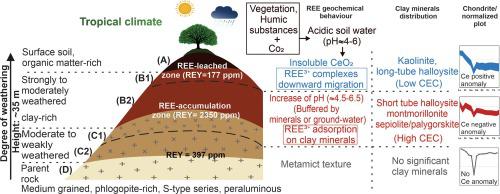当前位置:
X-MOL 学术
›
J. Asian Earth Sci.
›
论文详情
Our official English website, www.x-mol.net, welcomes your
feedback! (Note: you will need to create a separate account there.)
Comparison of characteristics and geochemical behaviors of REEs in two weathered granitic profiles generated from metamictized bedrocks in Western Peninsular Malaysia
Journal of Asian Earth Sciences ( IF 2.7 ) Pub Date : 2020-09-01 , DOI: 10.1016/j.jseaes.2020.104385 Ali Yaraghi , Kamar Shah Ariffin , Norlia Baharun
Journal of Asian Earth Sciences ( IF 2.7 ) Pub Date : 2020-09-01 , DOI: 10.1016/j.jseaes.2020.104385 Ali Yaraghi , Kamar Shah Ariffin , Norlia Baharun

|
Abstract Rare earth elements (REEs), an important group of non-energy minerals, are vital to industrialized societies worldwide. Southeast Asian granitic belts are potential sources of ion-adsorption REE clays comprising large weathered granitic crusts that often have high-grade ion-adsorbed REEs. Characterization studies were conducted on representative samples from two sites, namely Lumut (LU) and Telok Murok (TM), located within the Malaysian Western granite belt. In both profiles, parent rocks were documented as medium-grained mica (phlogopite)-rich, S-type, peraluminous, ilmenite-series granite with metamict texture. Quartz, K-feldspar, and mica were major minerals, while REE-bearing accessory minerals were apatite, allanite, monazite, xenotime, and zircon. Al2O3 and LOI contents increased with depth in both weathered profiles, whereas P2O5 tended to be constant. Long-tube halloysite and kaolinite are abundant clays in the upper portions of the profiles, whereas the lower parts were rich in short-tube halloysite with smectite. Moreover, the depletion of REE + Y (REY) content in horizon A (B1) was clear, whereas REY was abundant in horizon B and/or C. The maximum content of REY could reach up to approximately 850 and 2350 ppm in horizon B2 and/or C in the LU and TM sites, respectively. Total REE content of the weathered crust was relatively elevated compared with that of the parent rocks (3–7 times) in the lower portions of both sites due to “high adsorption capacity” of abundant clay minerals in the deep profiles. Enrichment in LREE and HREE was indicated in the LU and TM sites, respectively. Trial leaching experiments with high-grade samples from both sites were conducted using ammonium sulfate. High recovery in the results proved REE adsorption by the clays in the lower parts of the profiles.
中文翻译:

马来西亚西半岛变质化基岩生成的两种风化花岗岩剖面中稀土元素的特征和地球化学行为比较
摘要 稀土元素(REEs)是一类重要的非能源矿物,对全球工业化社会至关重要。东南亚花岗岩带是离子吸附 REE 粘土的潜在来源,包括大型风化花岗岩壳,通常具有高品位离子吸附 REE。对来自马来西亚西部花岗岩带内的两个地点,即红土坎 (LU) 和 Telok Murok (TM) 的代表性样本进行了表征研究。在这两个剖面中,母岩都被记录为富含中粒云母(金云母)的 S 型过铝质钛铁矿系列花岗岩,具有变质岩结构。石英、钾长石和云母为主要矿物,含稀土元素的副矿物为磷灰石、褐铝石、独居石、磷钇矿和锆石。在两个风化剖面中,Al2O3 和 LOI 含量随着深度的增加而增加,而 P2O5 趋于恒定。剖面上部长管埃洛石和高岭石为丰富的粘土,而剖面下部则富含短管埃洛石和蒙脱石。此外,层 A (B1) 中 REE + Y (REY) 含量的消耗很明显,而层 B 和/或 C 中 REY 含量丰富。 REY 的最大含量在层 B2 中可达到约 850 和 2350 ppm和/或 C 分别位于 LU 和 TM 位点。由于深层剖面中丰富的粘土矿物的“高吸附能力”,风化壳的总稀土元素含量与两个地点下部的母岩相比相对升高(3-7倍)。LREE 和 HREE 的富集分别显示在 LU 和 TM 位点。使用硫酸铵对来自两个地点的高品位样品进行了浸出试验。结果中的高回收率证明了剖面下部粘土对稀土的吸附。
更新日期:2020-09-01
中文翻译:

马来西亚西半岛变质化基岩生成的两种风化花岗岩剖面中稀土元素的特征和地球化学行为比较
摘要 稀土元素(REEs)是一类重要的非能源矿物,对全球工业化社会至关重要。东南亚花岗岩带是离子吸附 REE 粘土的潜在来源,包括大型风化花岗岩壳,通常具有高品位离子吸附 REE。对来自马来西亚西部花岗岩带内的两个地点,即红土坎 (LU) 和 Telok Murok (TM) 的代表性样本进行了表征研究。在这两个剖面中,母岩都被记录为富含中粒云母(金云母)的 S 型过铝质钛铁矿系列花岗岩,具有变质岩结构。石英、钾长石和云母为主要矿物,含稀土元素的副矿物为磷灰石、褐铝石、独居石、磷钇矿和锆石。在两个风化剖面中,Al2O3 和 LOI 含量随着深度的增加而增加,而 P2O5 趋于恒定。剖面上部长管埃洛石和高岭石为丰富的粘土,而剖面下部则富含短管埃洛石和蒙脱石。此外,层 A (B1) 中 REE + Y (REY) 含量的消耗很明显,而层 B 和/或 C 中 REY 含量丰富。 REY 的最大含量在层 B2 中可达到约 850 和 2350 ppm和/或 C 分别位于 LU 和 TM 位点。由于深层剖面中丰富的粘土矿物的“高吸附能力”,风化壳的总稀土元素含量与两个地点下部的母岩相比相对升高(3-7倍)。LREE 和 HREE 的富集分别显示在 LU 和 TM 位点。使用硫酸铵对来自两个地点的高品位样品进行了浸出试验。结果中的高回收率证明了剖面下部粘土对稀土的吸附。











































 京公网安备 11010802027423号
京公网安备 11010802027423号